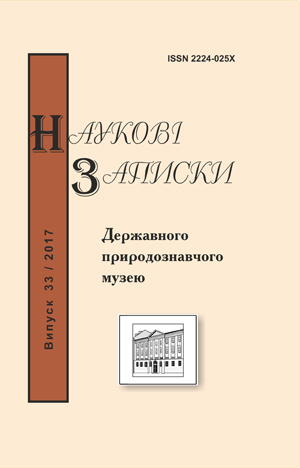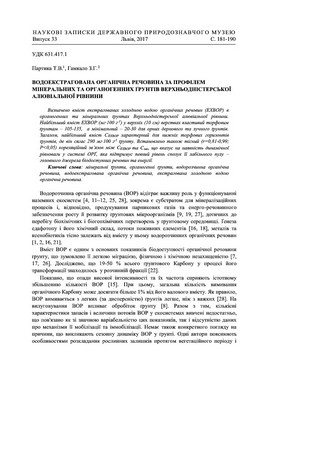Main
/
/
Partyka T., Hamkalo Z. Water-extractable organic matter in the profile of mineral and organic soils of Upper Dniester alluvial plane // Proc. of the State Nat. Hist. Mus. - Lviv, 2017. - 33. - P. 181-190.
DOI: https://doi.org/10.36885/nzdpm.2017.33.181-190
Key words: Mineral soils, organic soils, water soluble organic matter, water-extractable organic
matter, cold water extracted organic matter
Content of cold water extracted organic matter (CWEOM) in organic and mineral soils of Upperdniester alluvial plane was estimated. The largest CWEOM content (mg∙100 g-1) in the upper (10 cm) soil layers was found in peat soils – 105-135, and the smallest – 20-30– in arable sod and meadow soils. The highest CWEOM content was found in the lower horizons of peat soil, where it reaches 290 mg∙100 g-1. Strong correlation (r=0.81 -0.99; P<0.05) between CWEOM and TOC was found. It indicates the presence of dynamic equilibrium in the SOM system that supports certain level of labile pool compounds – the main source of bioavailable materials and energy.
References
- Dobrovolskii G.V., Trofimov C.Ia., Sedov S.N. Uglerod v pochvakh i landshaftakh Severnoi Evrazii // Krugovorot ugleroda na territorii Rossii: izbr. nauch. trudy po probleme "Globalnye izmeneniia biosfery. Antropogennyi vklad". – M., 1999. – S. 233-270. [In Russian]
- Mukhin E.V. Ekologicheskie funktcii i migratciia vodorastvorimykh organicheskikh veshchestv v pochvakh lesoparkovykh landshaftov nizhnego techeniia reki Severnoi Dviny: avtoref. diss. … kand. biol. nauk. – Moskva, 2007. – 24 s. [In Russian]
- Semenov V.M., Kuznetcova T.V., Ivannikova L.A., Semenova N.A. Puly i fraktcii organicheskogo veshchestva pochv: sovremennye kontceptcii i metody issledovaniia // Organizatciia pochvennykh sistem: metodologiia i istoriia pochvovedeniia. – Pushchino, 2007. – S. 155-159. [In Russian]
- Partyka T.V., Hamkalo Z.H., Bedernichek T.Yu. Osoblyvosti kilkisnykh zmin vodorozchynnoi orhanichnoi rechovyny v bolotnykh edafotopakh Verkhnodnisterskoho Peredkarpattia vnaslidok torf’ianykh pozhezh // Ekosystemy, yikh optymizatsiia ta okhorona. – Simferopol: TNU, 2012. – Vyp. 6. – S. 257-263. [In Ukrainian]
- Partyka T.V., Bedernichek T.Yu. Rol labilnoi orhanichnoi rechovyny gruntu v ahrehatoutvorenni // Mat-ly Vseukr. nauk.-prakt. konf. molodykh vchenykh "Aktualni problemy ahropromyslovoho vyrobnytstva Ukrainy" (s. Obroshyno, Lvivskoi oblasti, 18 lystopada 2015 r.). – Lviv-Obroshyno, 2015. – S. 54-56. [In Ukrainian]
- Tiurin I.V. Organicheskoe veshchestvo pochv i ego rol v plodorodii. – M.: Nauka, 1965. – 319 s. [In Russian]
- Armolaitis K., Aleinikovienė J., Lubytė J., Žėkaitė V., Garbaravičius P. Stability of soil organic carbon in agro and forest ecosystems on Arenosol // Zemdirbyste-Agriculture. – 2013. – Vol. 100 (3). – P. 227-234.
- Brye K.R., Norman J.M., Bundy L.G., Gower S.T. Nitrogen and carbon leaching in agroecosystems and their role in denitrification potential // Journal of Environmental Quality. – 2001. – Vol. 30. – P. 58-70.
- Ghani A. Bioavailability of dissolved organic carbon and nitrogen leached or extracted from pasture soils [Електронний ресурс] // In: Adding to the knowledge base for the nutrient manager. – New Zealand. – 9 p. – Режим доступу: http://www.massey.ac.nz/~flrc/workshops/11/paperlist11.htm. – Назва з екрана.
- Ghani A., Dexter M., Perrott K. W. Hot-water extractable carbon in soils: a sensitive measurement for determining impacts of fertilisation, grazing and cultivation // Soil Biology and Biochemistry. – 2003. – Vol. 35. – P. 1231 -1243.
- Gregorich E.G., Beare M.H., McKim U.F., Skjemstad J.O. Chemical and biological characteristics of physically uncomplexed organic matter // Soil Science Society of America Journal. – 2006. – Vol. 70 (3). – P. 975-985.
- Gregorich E.G., Beare M.H., Stoklas U., St-Georges P. Biodegradability of soluble organic matter in maize-cropped soils // Geoderma. – 2003. – № 113. – P. 237-252.
- Hamkalo Z., Bedernichek T. Total, cold and hot water extractable organic carbon in soil profile: impact of land-use change // Zemdirbyste-Agriculture. – 2014. –Vol. 101. –№ 2. – P. 125-132. Haynes R.J. Labile organic matter fractions as central components of the quality of agricultural soils: an overview // Advances in agronomy. – 2005. – Vol. 85. – Р. 221 -268.
- Hongve, D., van Hees P.A.W., Lundstrom U.S. Dissolved components in precipitation water percolated through forest litter // European Journal of Soil Science. – 2000. – Vol. 51. – P. 667-677.
- Kaiser K., Kaupenjohann M., Zech M. Sorption of dissolved organic carbon in soil: effects of soil sample storage, soil-to-solution ratio, and temperature // Geoderma. – 2001. – Vol. 99. – P. 317-328.
- Liaudanskienė I., Šlepetienė A., Šlepetys J., Stukonis V. Evaluation of soil organic carbon stability in grasslands of protected areas and arable lands applying chemo-destructive fractionation // Zemdirbyste-Agriculture. – 2013. – Vol. 100 (4). – P. 339-348.
- Lofts S., Simon B. M., Tipping E., Woof C. Modelling the solid-solution partitioning of organic matter in European forest soils // European Journal of Soil Science. – 2001. – Vol. 52. – P. 215-226.
- Marschner B., Kalbitz K. Controls of bioavailability and biodegradability of dissolved organic matter in soils // Geoderma. – 2003. – Vol. 113. – P. 211 -235.
- Ostrowska A., Porębska G., Kanafa M. Carbon accumulation and distribution in profiles of forest soils // Polish Journal of Environmental Studies. – 2010. – Vol. 19 (6). – P. 1307-1315.
- Parkin T.B., Kaspar T.C. Temperature controls on diurnal carbon dioxide flux: Implications for estimating soil carbon loss // Soil Science Society of America Journal. – 2003. – Vol. 67. – P. 1763-1772.
- Qualls R.G., Bridgham S.D. Mineralization rate of 14C – labeled dissolved organic matter from leaf litter in soils of a weathering chronosequence // Soil Biology and Biochemistry. – 2005. – Vol. 37 (5). – P. 905-916.
- Rees R.M., Parker J.P. Filtration increases the correlation between water extractable organic carbon and soil microbial activity // Soil Biology and Biochemistry. – 2005. – Vol. 37 (12). – P. 2240-2248.
- Six J., Elliott E.T., Paustian K. Soil macroaggregate turnover and microaggregate formation: A mechanism for C sequestration under no-tillage agriculture // Soil Biology and Biochemistry. – 2000. – Vol. 32. – P. 2099-2103.
- Slepetiene A., Amaleviciute K., Slepetys J., Volungevičius J. Stocks of total, humified and labile carbon as influenced by re-naturalisation of previously differently used peat soil // Fresenius Environmental Bulletin. – 2015. – № 6a. – P. 2152-2157.
- Šlepetienė A., Šlepetys J., Liaudanskienė I. Chemical composition of differently used Terric Histosol // Zemdirbyste-Agriculture. – 2010. – Vol. 97 (2). – P. 25-32.
- Staugaitis Z., Šlepetienė A., Tilvikienė V., Kadžiulienė Z.. Suminė ir labilioji anglis dirvožemyje tręšiant šunažolę mineralinėmis trąšomis ir biodujų gamybos šalutiniu produktu // Žemės ūkio mokslai. – 2016. – T. 23, № 3. – P. 123-129.
- Vinther F.P., Hansen E. M., Eriksen J. Leaching of soil organic carbon and nitrogen in sandy soils after cultivating grass-clover swards // Biology and Fertility of Soils. – 2006. – Vol. 43. – P. 12-19.
- Zsolnay A. Dissolved humus in soil waters // Humic substances in terrestrial ecosystems / Ed. by A. Piccolo. – Amsterdam: Elsevier, 1996. – P. 171 -224.


